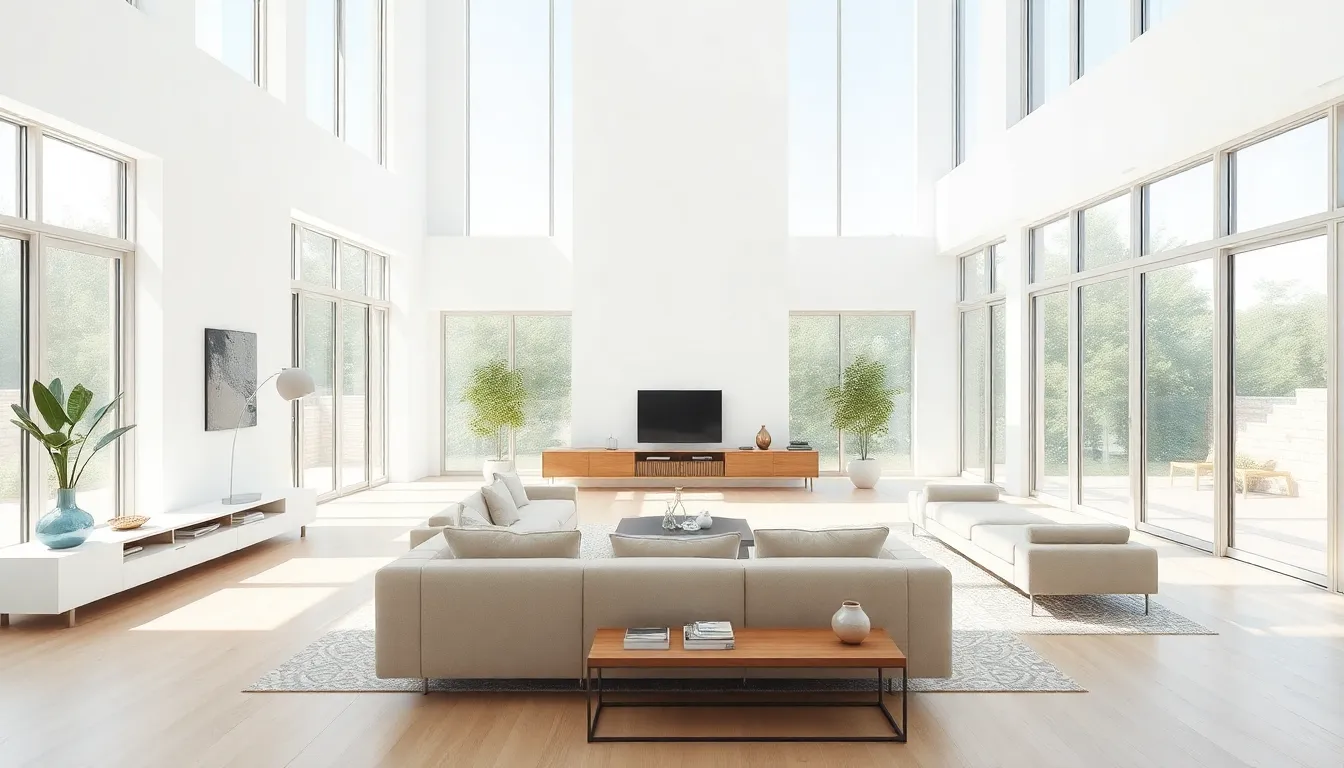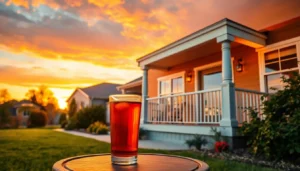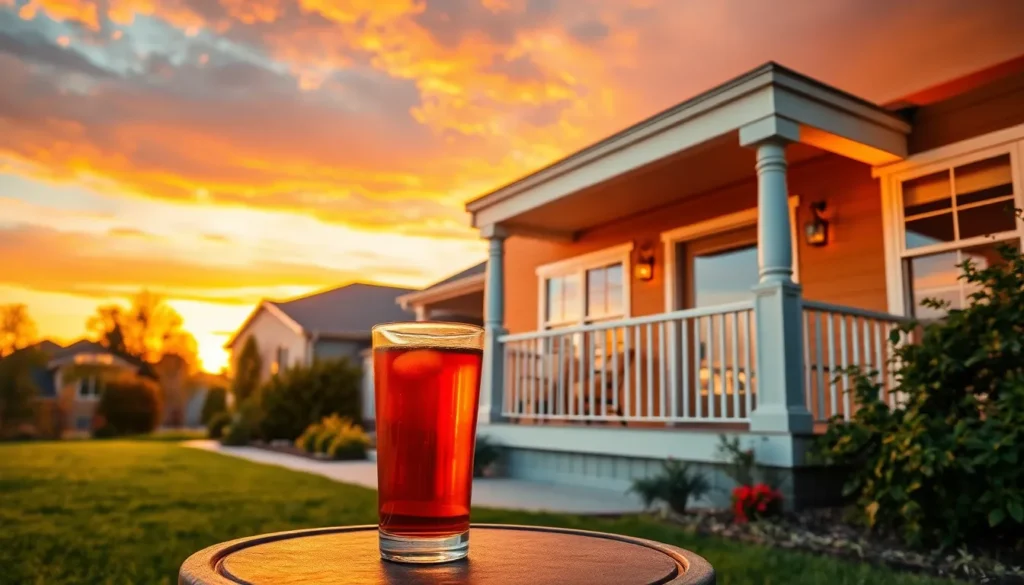Table of Contents
ToggleIn a world where minimalism reigns supreme and open-concept living is practically a rite of passage, modern home design has become the ultimate playground for creativity. Gone are the days of stuffy rooms and overstuffed couches; today’s homes are all about sleek lines, smart technology, and a splash of personality. If walls could talk, they’d probably brag about their eco-friendly materials and smart appliances that make life easier—and maybe even throw a little shade at the outdated décor of yesteryear.
Overview of Modern Home Design
Modern home design showcases a blend of functionality and aesthetics, reflecting lifestyle changes and technological advancements. An emphasis on minimalism prioritizes uncluttered spaces filled with light. Open-concept layouts facilitate social interaction, allowing rooms to serve multiple purposes.
Creativity flourishes in contemporary designs, which often feature striking architectural elements. Sleek lines define structures, creating a sense of flow and unity throughout the home. Smart technology integrates seamlessly, enhancing convenience with features such as automated lighting and climate control.
Eco-friendly materials gain traction among homeowners seeking sustainability in their designs. Natural finishes, recycled elements, and energy-efficient appliances underscore a commitment to environmental responsibility. The incorporation of greenery, whether through indoor plants or vertical gardens, enhances connections to nature.
Color palettes within modern homes often maintain neutrality, using shades like whites, grays, and earth tones. Accents introduce personality and warmth while still achieving a cohesive look. The thoughtful selection of furnishings aligns with individual lifestyles, balancing comfort and style.
Artwork and personal items play a crucial role in defining spaces. These elements offer insight into the homeowner’s identity and preferences, creating a distinctive atmosphere. Modern home design continually evolves, reflecting current trends while ensuring lasting appeal through adaptable themes.
Key Features of Modern Home Design

Modern home design incorporates several key features that enhance both functionality and style. An emphasis on open floor plans promotes fluid movement and interaction, allowing spaces to adapt to various needs.
Open Floor Plans
Open floor plans prioritize interconnected living spaces, blending kitchens, dining areas, and living rooms into one cohesive area. These designs break traditional barriers, facilitating easier social interaction among family and guests. Homeowners value the flexibility of multifunctional spaces, making it simple to host gatherings or enjoy quiet time. Such layouts create an illusion of a larger area, enhancing the overall aesthetic and usability of the home.
Natural Light and Windows
Natural light plays a crucial role in modern home design, with large windows and glass doors commonly utilized. Homeowners appreciate the connection to the outdoors as expansive openings bring in sunlight and warmth. Skylights also contribute to brightness, improving mood and energy efficiency. These well-placed windows reduce reliance on artificial light. Designers often opt for floor-to-ceiling windows, emphasizing views and creating an inviting atmosphere.
Minimalist Aesthetics
Minimalist aesthetics define modern home design through simplicity and functionality. Clean lines and uncluttered spaces lead to a calming environment. Essential furnishings and decor combine to create a sense of order. Neutral color palettes enhance this effect and allow for personal accents without overwhelming the space. Texture often replaces excessive ornamentation, showcasing materials instead. Homeowners focus on quality over quantity, resulting in thoughtfully curated living spaces.
Materials Commonly Used in Modern Home Design
Modern home design heavily relies on various materials that enhance aesthetics and functionality. Concrete, steel, glass, and wood form the backbone of contemporary construction, each contributing uniquely to the overall atmosphere of a space.
Concrete and Steel
Concrete provides durability and strength, forming the structural foundation of many modern homes. Its versatility allows for various finishes, from polished surfaces to raw textures, appealing to different design preferences. Steel supports large open spaces and creates bold architectural elements. Its strength enables expansive windows and unique rooflines, reflecting modern aesthetics that favor minimalism and clean lines. Builders increasingly choose these materials for their sustainable attributes, ensuring that modern homes remain resilient and environmentally conscious.
Glass and Wood
Large glass panels enhance natural light and connect indoor spaces to outdoor environments. This openness fosters warmth and comfort while visually expanding areas. Transparency invites nature into the home, offering delightful views and an airy feel. Wood complements glass with its organic textures and warmth. It introduces a sense of comfort and familiarity, adding warmth to contemporary designs. Emphasizing earthy tones, wood accents provide balance against the sleekness of glass and steel. Together, these materials create harmonious living spaces perfect for modern lifestyles.
Popular Trends in Modern Home Design
Modern home design embraces several innovative trends that reflect contemporary lifestyles. Sustainability and technology remain at the forefront of this evolution.
Sustainable Design Practices
Sustainable design practices play a significant role in modern homes. Eco-friendly materials like bamboo, recycled metal, and reclaimed wood are often incorporated to reduce environmental impact. Natural finishes, such as stone and clay, provide aesthetic appeal while promoting sustainability. Energy-efficient appliances, including smart thermostats and LED lighting, lower consumption and utility bills. Homes often utilize passive solar designs to enhance energy efficiency. Outdoor spaces frequently feature native plants, supporting local ecosystems. Biophilic design, which emphasizes a connection to nature, enhances well-being in residential environments.
Smart Home Technology
Smart home technology revolutionizes daily living through enhanced convenience and efficiency. Homeowners frequently use smart assistants to manage tasks, including temperature control and lighting adjustments. Security systems with smart cameras and locks ensure safety and peace of mind. Voice-controlled devices allow effortless management of various functions. Smart refrigerators track food inventory, reducing waste and promoting healthy eating. Integration of smart thermostats optimizes energy use, resulting in cost savings. Home automation systems enable personalized environments, catering to individual preferences and maximizing comfort. Overall, smart technology enhances modern home design, making living spaces more intuitive.
Modern home design represents a dynamic evolution that embraces minimalism and functionality. The seamless integration of smart technology and sustainable materials not only enhances daily living but also reflects a commitment to environmental responsibility.
As open-concept layouts continue to dominate, they foster a sense of community while maximizing space. The emphasis on natural light and neutral palettes creates a serene atmosphere that resonates with contemporary lifestyles.
Ultimately, modern home design is about more than aesthetics; it’s about creating spaces that inspire and adapt to the needs of those who inhabit them. This approach ensures that homes remain both stylish and functional for years to come.










